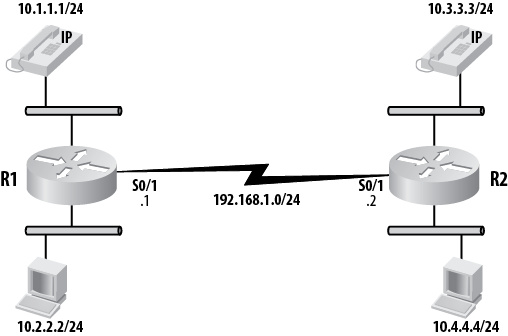Chapter 34. The Converged Network
In this chapter, you’ll see a converged network in action. While the network will be very simple, the principles shown will scale to networks and links of almost any size.
Figure 34-1 shows the network we’ll use for the examples in this chapter. R1 and R2 each have two Ethernet networks attached: one with an IP phone and one with a personal computer. The routers are connected with a T1 that terminates into S0/1 on each.

Figure 34-1. Simple converged network
Configuration
The interface we’ll be concentrating on is S0/1 on R1. Here is the configuration:
interface Serial0/1 ip address 192.168.1.1 255.255.255.0 service-policy output WAN
The service-policy statement maps the policy map named WAN
to the interface. Here is the configuration for the policy map:
policy-map WAN
class Voice-RTP
priority 128
class Voice-Control
bandwidth percent 5
class HTTP
bandwidth percent 10
class class-default
fair-queueThe policy map references four classes:
Voice-RTP, Voice-Control,
HTTP, and the special class
class-default. Remember that
class-default is a special class name used when you’re
building the default class. The default class is where packets not
matching any other class are queued. The queues are designed as
follows:
Voice-RTPPackets in this class will be put into the strict priority queue. The queue will be sized for 128 Kbps. This is roughly the size of two 64 Kbps ...